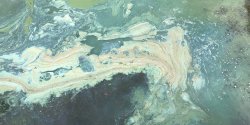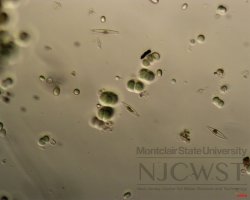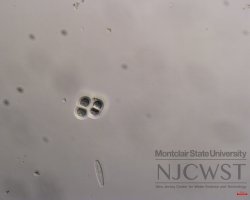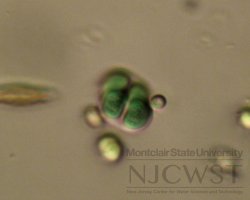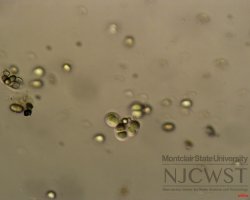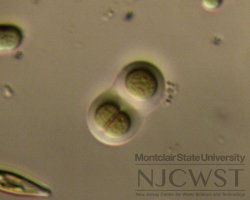Taxonomy
- Order
- Chroococcales
- Family
- Chroococcaceae
- Genus
- Chroococcus
Examples of Chroococcus
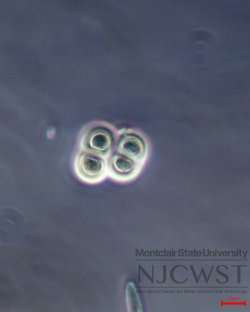
400X total magnification; 10 μm scale bar. Phase contrast.
Morphology
Colonies are gelatinous, irregular to roughly spherical in shape; usually composed of a small group of up to 16 cells, and commonly with only one to four cells per colony; within colonies, cells sometimes form packet-like groups of 2-8 cells. Colonies usually do not contain a large number of cells; only rarely forming large agglomerations of many cells. Cells, or groups of cells, are surrounded by colorless or yellowish mucilaginous envelopes; envelopes typically copy the cell outline and have distinct margins, and are often concentrically lamellated (layered). Cells are at first oval to spherical in shape; following division, hemispherical or in the shape of a segment of a sphere (often looks like a sphere cut into four slices); cells do not reach their original spherical shape before the next round of division*. Cell size can reach up to 50 μm in diameter. Cell content may be grey, greenish-grey, blue-green, olive-green, yellowish, orange, reddish, or violet in color; homogeneous or granular; aerotopes present only in a few planktic species.
*The genus Limnococcus, whose cells do reach (roughly) their original form before dividing again, was derived from Chroococcus; Limnococcus was previously classified as a subgenus of Chroococcus.
Ecology
Chroococcus is distributed across North America. Most species are metaphytic, and the most common are found in somewhat acidic wetlands, but the genus also includes epiphytic and periphytic species, and may be found in ponds and lakes (freshwater). More rarely aerophytic or in thermal springs.
References
- Johansen, J. R., & Komárek, J. (2015). Coccoid Cyanobacteria. In J. D. Wehr, R. G. Sheath, & J. P. Kociolek (Eds.), Freshwater Algae of North America: Ecology and Classification (2nd ed., pp. 97-109). Waltham, MA: Elsevier.
- Komárek, J. & Anagnostidis, K. (2008). Cyanoprokaryota-1. Teil/Part 1: Chroococcales. In H. Ettl, G. Gärtner, H. Heynig, & D. Mollenhauer (Eds.), Süßwasserflora von Mitteleuropa (Vol. 19/1, pp. 279-281). Heidelberg, Germany: Spektrum.
